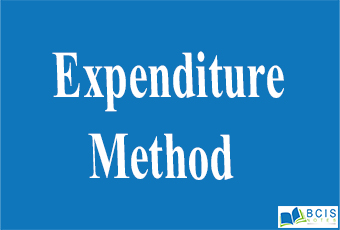
Expenditure Method of Measuring National Income
The expenditure method is also said to be the spending approach. Under the expenditure method, all types of expenditure made by households, firms and government on final products are evaluated to calculate GDP. It is the most common way to estimate GDP.
This method says everything that the private sector, including consumers and private firms, and government spend within the borders of a particular country, must add up to the total value of all finished goods and services produced over a certain period of time. This method produces nominal GDP, which must then be adjusted for inflation to result in the real GDP.
Symbolically,
National income = C + I + G + (X − M)
Where,
C = Consumption by residents of the nation
I = Investment
G = Government spending
X = Exports
M = Imports
Or National income = C + I + G + NX
Where,
Net exports (NX) = Exports – Imports
Components of Expenditure Method
- Private (or Personal) consumption Expenditure (C)
It included all types of expenditure made on final goods and services including those produced abroad by the individuals or households of the country. It includes:
- expenses on durable goods
- expences on non-durable goods
- expenses incurred on services of all kinds
2. Gross Private Domestic Investment or Gross Capital Formation
It includes expenditures incurred by private enterprises on new investment and on replacement of old capital and also on inventory investment. It comprises the following expenditures:
- Non-residential investments- all expenses made by business firms
- Residential investments- all expenses made on factories, warehouses, business complex, office building and on new houses and apartments
- Changes in business inventories- The difference between closing stock and the opening stock in the specified time
- Depreciation- The value that wears out during the period over which economic activity is being measured
3. Government expenditure
Expenditures made by the government (central, state or local) on final goods or services, including those produced abroad are a part of GDE (GDP). Expenditures on obligatory functions e.g. security expenses, administrative expenses etc and on optional functions (or socio-economic infrastructures) are added to government expenditures. But expenditures on transfer payments ( social security, benefits like pension, unemployment allowances, scholarship, etc) are not added because these payments are not made in exchange for goods and services produced during the current period.
4. Net Foreign Investment (X-M)
Net foreign investment (which is also referred to as net capital outflow) is the total amount of investment overseas done by people in the domestic economy minus the investment from people overseas in the domestic economy. The difference in the value of a country’s total export and total import in one fiscal year is termed net exports. Exports are regarded as an economy’s output, while imports are regarded as expenses since they are produced outside the national boundaries of a country. A country’s total trade is measured by net exports and is also known as a balance of trade.
5. Net Factor Income from Abroad (NFIA) or Net Receipts(R-P)
Net Factor Income from Abroad is defined as the income paid to domestic factors of production by the rest of the world minus income paid to foreign factors of production by the domestic economy. In other words, it is the difference between the factor income received from abroad by normal residents of a country fro rendering factor services in other countries and the factor incomes paid to the foreign residents for their factor services within the domestic territory of a country.
You may also like Importance and Uses of National Income || National Income || Bcis Notes

Leave a Reply